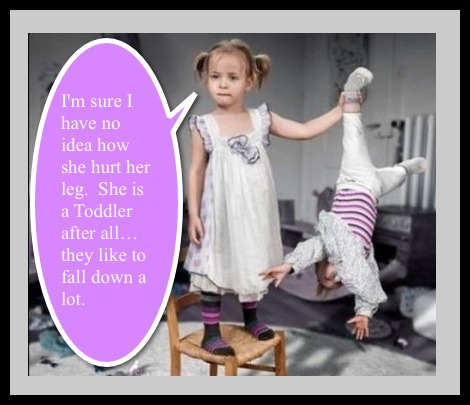Toddler’s Fracture
The limping toddler offers the opportunity for us to contemplate a wide differential that includes some significant pathologic processes. Does this child have avascular necrosis of the femoral head? Is there slipped capital femoral epiphysis? Is there evidence of rheumatologic disease? Should I be concerned for psoas muscle abscess? Do I need to consider malignancies? Is there septic arthritis or is this transient synovitis? Do I need to worry about non-accidental trauma? These are all great questions and often lead to a substantial evaluation. But, once all of our x-rays have returned normal and our 8 million non-specific lab tests are unenlightening, we commonly shrug our shoulders and attempt to reassure the family: “Perhaps it is a strain or a sprain or a contusion.” The next time you hear yourself utter something similar to this after a “normal” evaluation of the limping child, make sure you re-consider Toddler’s Fracture.
Toddler’s Fracture
- Also known as “Childhood Accidental Spiral Tibial (CAST) fracture.”
- Typically seen in ambulatory toddlers (9 months to 3 years).
- Fracture is not displaced.
- Spiral or oblique pattern.
- Involves distal half to distal third of the tibia.
- Fractures of the more proximal tibia may be suspicious for non-accidental trauma.
- Often as a result of minor mechanism, many times with a rotational component.
- Initial x-rays commonly do not show evidence of Toddler’s Fracture (13-43%).
History & Physical Exam Clues
- Minor fall – then refusal to bear weight.
- Lack of systemic symptoms (ex, fever, other swollen joints, failure to thrive).
- Localized tenderness over tibia.
- Warmth over tibia
- Pain with Dorsiflexion of Ankle.
- Pain with gently twisting the tibia area.
- HOWEVER, No set of clinical criteria are sensitive enough to rule-out the condition.
What to do with the child who limps, has normal labs, and normal x-rays?
- Re-examine after analgesics.
- Attempt to elicit tenderness over the Tibia, the Base of 1st Metatarsal and Cuboid, and the Calcaneous (all injuries potentially difficult to view on xrays).
- If there is local tenderness, consider additional x-ray images of that area (ex, oblique tibial images).
- Often additional images are also not enlightening though.
- Reassess all of the joints and their respective Range of Motion.
- Reassess the abdomen and genitals (make sure we didn’t get distracted from the real problem).
- If you do not believe that this limping is due to joint pathology or other systemic illness, then have a low threshold for casting as if it is a Toddler’s Fracture.
-
“If a well child presents with a clear-cut history of trauma and is unable to bear weight on the affected extremity, we recommend a long-leg cast regardless of negative radiographic findings. This will necessarily place children in casts for 2-3 weeks who do not have fractures; nevertheless, it precludes leaving an occult toddler’s fracture untreated.” – Halsey MF. J Pediatric Orthop (2001)
- While there is no evidence in the literature to suggest that casting speeds healing, it does decrease the risk of displacement.
-
- There is newer literature that supports the use of ultrasound to help diagnose the subtle fractures
- While I am good with Ultrasound, I am not, personally, facile enough to rule-out the presence of a Toddler’s Fracture (but it gives me something new to learn)!
Moral of the Morsel
Lewis D, Logan P. Sonographic diagnosis of toddler’s fracture in the emergency department. J Clinical Ultrasound. 2006; 34(4): 190-194. Sawyer JR, Kapoor M. The limping child: a systematic approach to diagnosis. Am Fam Physician. 2009; 79(3): 215-224. Halsey MF, Finzel KC, Carrion WV, Haralabatos SS, Gruber MA, Meinhard BP. Toddler’s fracture: presumptive diagnosis and treatment. J Pediatr Orthop. 2001; 21(2): 152-156. John SD, Moorthy CS, Swischuk LE. Expanding the concept of the toddler’s fracture. Radiographics. 1997; 17(2): 367-376.After you have done your thorough work up on the limping toddler… don’t be so quick to say that it is just a strain/sprain/bruise… recall that these little kidos are more likely to fracture a bone than strain a ligament.



[…] often bring additional considerations into play when evaluating kids for possible fractures (ex, Toddler’s Fracture, Nasal Fractures, Pelvic Avulsion Fractures). We have already discussed how Ankle Injuries need to […]
In the past a child presenting with a spiral fx was generally a good indication that the child is a victim of abuse. Are you now saying that a spiral fx is not an indication of having an arm or leg twisted? Should this not be the case would you please enlighten me.
Correct. The spiral fracture can occur from accidental trauma as well as non-accidental trauma / abuse. So, it does not equate to abuse.
Thank you, Sean
In the past a child presenting with a spiral fx was generally a good indication that the child is a victim of abuse. Are you now saying that a spiral fx is not an indication of having an arm or leg twisted?
Great post! Have nice day ! 🙂 uukwk
Thank you for another excellent post. I always check your site first for any pediatric question.
Tom
[…] Toddler’s Fracture – Nice pearl: little kidos are more likely to fracture a bone than strain a ligament. […]
Thankyou – a very good review. By the way, the word facile does not mean proficient. Facile has an entirely different meaning.